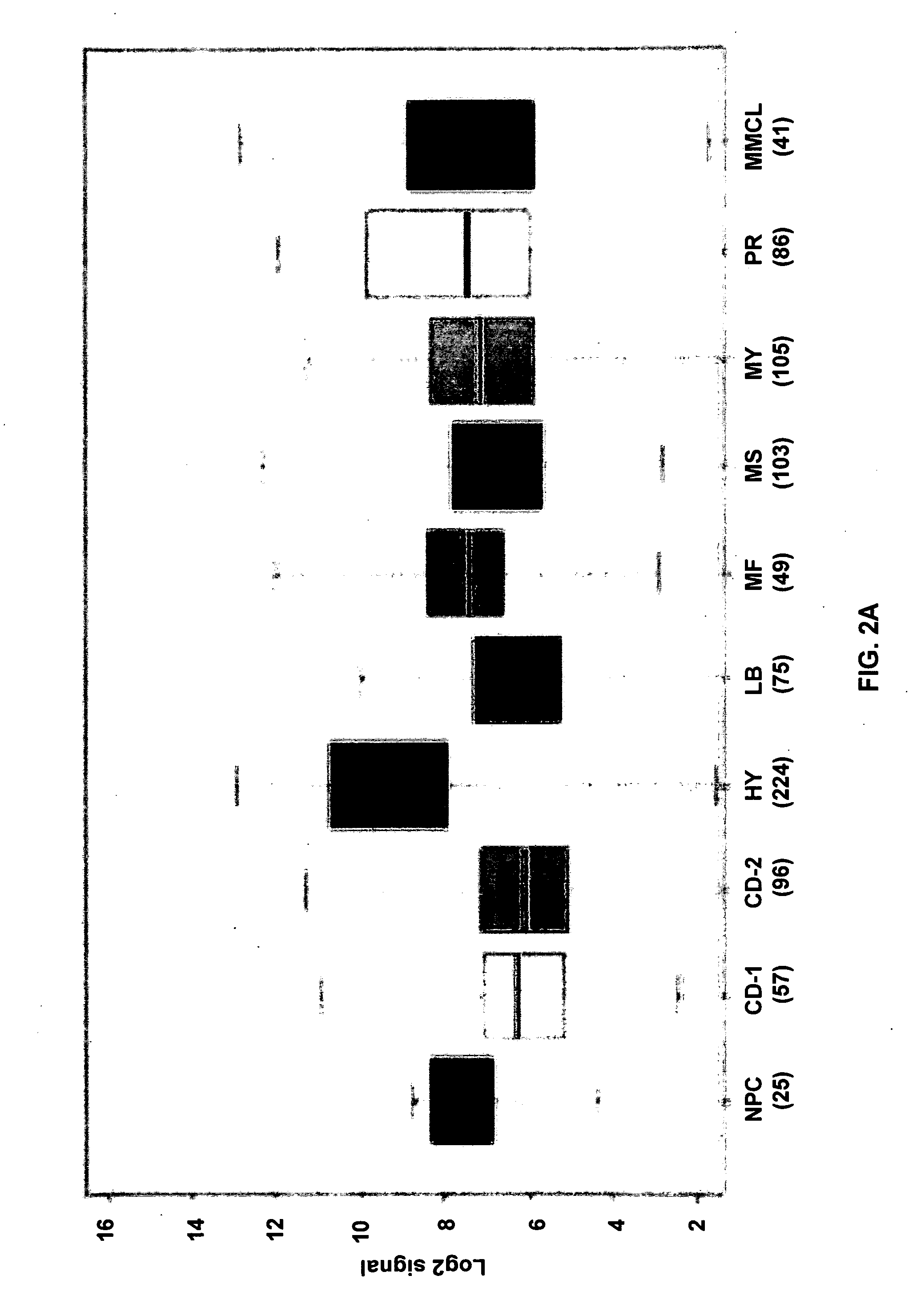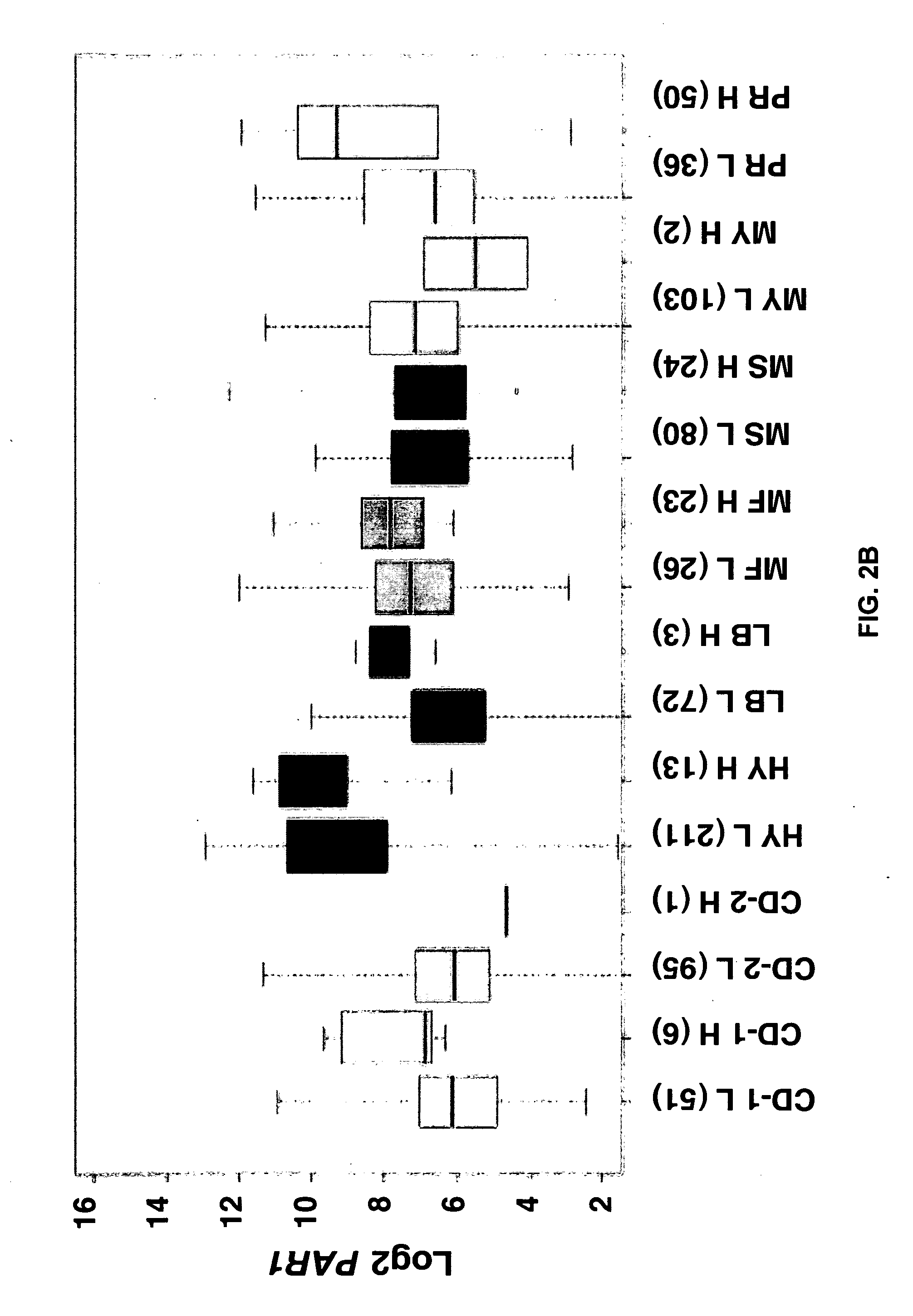Copy Number Variant-Dependent Genes As Diagnostic Tools, Predictive Biomarkers And Therapeutic Targets
- Summary
- Abstract
- Description
- Claims
- Application Information
AI Technical Summary
Benefits of technology
Problems solved by technology
Method used
Image
Examples
example 1
Multiple Myeloma Genes with Overexpression Correlating with Copy Number Changes
[0078]The Broad Institute / MMRF / MMRC consortium recently reported on the whole genome sequencing of 38 myeloma genomes. Clustering of mutations in components of complement cascade-thromboembolytic cascade in multiple myeloma were examined. Together these data strongly implicate the PAR1 pathway as playing a significant role in myelomagenesis. In a proteomic study, a substantial proportion of multiple myeloma cases exhibited phosphorylation of virtually all signaling molecules in extracts of purified multiple myeloma cells. Given the pleotropic effects of PAR activation, multiple myeloma is strongly correlated with the overexpression of PAR1.
[0079]Cells were isolated from bone marrow of newly diagnosed myeloma patients and separated into aliquots with one being subjected to GEP and the other, aCGH, analyses. Copy number variant-dependent (CNV) genes in CD138-selected plasma cells genes were identified and r...
example 2
Gene Upregulation in Multiple Myeloma and MGUS
PAR1 is Upregulated in Myeloma Plasma Cells, Focal Osteolytic Lesions
[0080]While PAR1 expression is normally low in plasma cells isolated from healthy donors, it progressively increases from the benign MGUS to relapsed multiple myeloma. PAR1 expression is highest in plasma cells isolated from so called focal lesions or medullary plasmacytomas of the bone. Expression of PAR1 is not altered in the related plasma cell malignancy Waldenstrom's macroiglobulinemia. Consistently, Waldenstrom's macroglobulinemia does not exhibit gains of chromosome 5. While PAR1 activation has been shown in cancer, multiple myeloma is the first malignancy where PAR1 activation can be attributed to a genetic lesion, that is, increased copy number of the PAR1 gene. As such, PAR1 signaling may contribute to multiple myeloma disease pathogenesis. It is likely that PAR1 activation primarily occurs via thrombin-mediated cleavage of PAR1.
[0081]Purified plasma cells are...
example 3
Levels of PAR1 Gene Expression are Associated with the Size of PAR1 / F2R-Positive Subpopulations in HMCLs and Bone Marrow Aspirates
[0097]The full-length open reading frame of PAR1 / F2R in a panel of HMCLs was measured using a semi-quantitative RT-PCR method (FIG. 9). The HMCLs demonstrated various levels of PAR1 expression. Using flow cytometry, it was found that not all the cells in a cell line express the PAR1 surface marker and that a subset of cells have the PAR1-positive phenotype combined with weak CD138 and CD38 expression (PAR1+ / CD138dim / CD38dim) (FIG. 10). It was also demonstrated that the size of the PAR1+ subpopulation correlates with the quantitative levels of PAR1 gene expression in the cell lines and that cells expressing PAR1 represent a distinct population in a homogenous cell line. In primary myeloma bone marrow, PAR1+ cells were also detected with similar phenotypic markers as HMCLs (FIG. 11). It is contemplated that PAR1 expression is a tangible phenotype that allow...
PUM
| Property | Measurement | Unit |
|---|---|---|
| Volume | aaaaa | aaaaa |
| Electrical resistance | aaaaa | aaaaa |
| Molecular weight | aaaaa | aaaaa |
Abstract
Description
Claims
Application Information
 Login to View More
Login to View More - R&D
- Intellectual Property
- Life Sciences
- Materials
- Tech Scout
- Unparalleled Data Quality
- Higher Quality Content
- 60% Fewer Hallucinations
Browse by: Latest US Patents, China's latest patents, Technical Efficacy Thesaurus, Application Domain, Technology Topic, Popular Technical Reports.
© 2025 PatSnap. All rights reserved.Legal|Privacy policy|Modern Slavery Act Transparency Statement|Sitemap|About US| Contact US: help@patsnap.com



